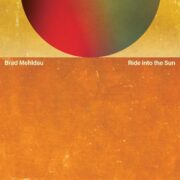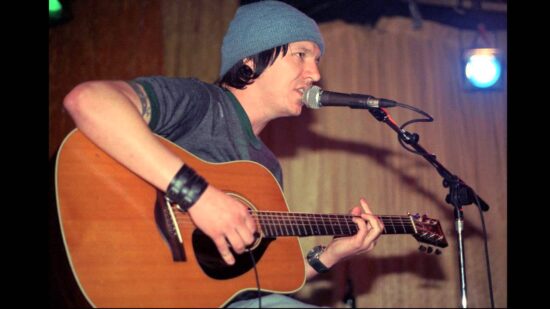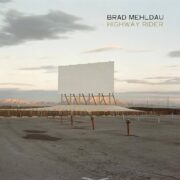The late-night television talk show world may be under siege with vitriol from Donald Trump and woes of financial insecurity. Yet on an August evening on the stage of ABC’s Jimmy Kimmel Live, pianist Brad Mehldau is making everything sound fine and free with the help of his bandmates Chris Thile, Matt Chamberlain and Felix Moseholm, performing the bittersweet “Colorbars.”

Accustomed as audiences are regarding Mehldau’s full, ripe textures, alt-harmonic structures and piquant melodicism — both on his own compositions and those of pop maestros Paul Simon, Briant Wilson, Lennon-McCartney, Thom Yorke and Jonny Greenwood — the desire to essay the lonesome rumination of Smith is not a shock. That’s especially true since Mehldau has worked with Smith’s famed eccentric producer, Jon Brion, on the pianist’s Largo (2002) and Highway Rider (2010).
Right before his appointment with Jimmy Kimmel’s couch, the pianist spoke to JazzTimes about all things alt- and astounding within the framework of Ride into the Sun.
Did the influence of Jon Brion have anything to do with you keying into the Elliott Smith process?
John Davis recorded and mixed this new record at his studio in Williamsburg, the Bunker, where I’ve done a few records, and he also played bass on several tracks. John and I talked a lot about how we wanted to approach the recording, and my work with Jon [Brion] on those two records was certainly a reference.
We were influenced by the way Jon recorded drummer/percussionist Matt Chamberlain, who also plays on the new record, and how he approached the orchestra. Jon favors a very dry approach, and we took some of that, but not all of it. In general, Jon Brion is amazing at achieving transparency in a very dense texture with a lot of things going on at once, like a rock-oriented band and orchestra in this case. You hear every musical gesture distinctly.
Another model for us would be Nigel Goodrich, not just on Radiohead stuff with orchestra, but also Beck’s Sea Change — he recorded strings with more echo and atmosphere, but still kept the band distinct and pristine.
So, since Brion’s work with Smith was on your mind, why do you believe it took 16 years to make this record a reality? Just marinating?
“Yes” would be the short answer. But I think some of it had to do with facing down a personal crisis I had four or so years ago. I went through a major depressive episode. When I came out of that, I felt like I could understand a bit more what Elliott was going through in his own suffering. And then it was like, okay, let’s do this. I had thought about a record that would focus on Elliott’s music for a number of years.
It also took time to figure out the approach. Would it be piano solo, or a group, or orchestral? Vocals, no vocals? Finally, I accepted that I couldn’t decide on one approach, and gave myself permission to use a variety of orchestrations, from piano solo all the way to orchestra and band, and to have vocals only on selected tracks. Once I did that, I could write and plan, and it moved quickly.
What about someone who might love Smith’s songs with [Portland indie band] Heatmiser, but they’re missing something within the whispers of his solo work? What are the nuances of his lyrics and melodies that you picked up on and fell in love with?
I like some of the Heatmiser stuff as well. I listen to it and can hear where he’s going to go a few years later, on a tune like “Half Right” — there’s this kind of holiness to it. It has a feeling of “Amen” in those cadences.
The thing that drew me to Elliott Smith was his harmony. My last record explored the music of composer Gabriel Fauré, and the attraction was the same. Yes, the melodies are alluring, but it’s the harmony that underpins them which is surprising and magical and gives a strong feeling. You hear that on guitar-driven songs like “Tomorrow Tomorrow,” but also on piano-centered songs like “Everything Means Nothing to Me.”
As you reached across Smith’s song catalog to include his inspirations such as Nick Drake, did who you believe he was as a person also feed into your wonderment?
I see him as someone who suffered and made beautiful music in spite of the suffering, and also, more complexly, out of the suffering. I think many people feel this too in his music.
Not that you have to make comparisons, but as a composer, what do you believe Smith does similarly — at least on the songs you have captured here — to, say, other composers you have covered such as Jerome Kern, Richard Rodgers, Lennon-McCartney, Thelonious Monk?
Well, there’s really a Lennon-McCartney connection. Elliott certainly knew the last five Beatles records. You hear the weird harmonic landscape of “Strawberry Fields Forever” or “I Am the Walrus” as a predecessor to Elliott’s “Sweet Adeline,” for example.
I just absorbed the whole of the newly released Nick Drake box and find it fascinating that you included other parts of Smith’s musical/lyrical world beyond his own writing such as Alex Chilton’s Big Star stuff and Drake. Can you please tell me about reaching into the heart of Drake’s “Sunday” and pulling out what it is you found?
It’s such a mystical tune. In one sense, it’s perfectly executed, like something from a mature composer, in formal terms, in terms of its melody and harmony intertwining, economy of ideas. In another sense, it is only something that someone in their 20s could write — it’s so naive and sincere, it’s really naked and earnest. I’m addicted to it. Really, our recording did not vary that much from the original. I did something I’ve never really done before in the studio — I didn’t try to do anything “new” with our cover. It’s a tribute, simply put.
What was the first song of Elliott Smith’s that you began to play around with, and find the keys into, enough to record it? What was the process like? And do you feel as if you had to shift the “usuals” in your playing to make an Elliott Smith song “sing”?
I think the first song I did was “Bottle Up and Explode.” I would hear Elliott sing it at Largo in Los Angeles where I lived at the time, and I would go back and try to play it on piano.

Even though you are an unpredictable pianist, you have signatures, even if it is just muscle-memory stuff. Can you share anything about what it is of yours that stood you in good/great/best standing when it came to playing Smith’s songs?
I like the term “usuals,” because there are many on piano — there’s stuff that lays on the piano easily, and we pianists are attracted to that. Around the time I was listening to a lot of Elliott Smith, I started trying to do guitar-strumming/finger-picking things on piano, and make it a texture in its own right. It was not pianistic. But I guess at this point this kind of texture has become a “usual” of mine.
Was there any song you chose that offered you trouble and therefore made your victory all the sweeter?
“Tomorrow Tomorrow” was the biggest challenge. I had wanted to play it for a long time, it just grabs me so strongly. Chris Thile and I tried to play it duo, but it wasn’t until we had the three of us, with Daniel Rossen [of Brooklyn indie band Grizzly Bear] playing guitar and singing, that I could finally find an approach — well, really, I should say we found the approach together. I think the reason why is because Elliott has several guitar tracks interwoven on the original, and you have to sort of uncover them and find a strategy. Daniel and Chris both knew the tune very well, and we found our way intuitively.

Matt is the guy I want if I’m in the mode of rock grooves, because he has a fat beat, informed by the music we both love, being of the same generation — music from the ’60s and ’70s, before the beat got smaller. But he is also this versatile sound/rhythm maker, and I knew that already from working with him on Highway Rider — he can create a percussive atmosphere that’s very non-obtrusive and subtle, but lights up the track. You can hear that on this record on something like “Southern Belle” or “Satellite.”
Same sort of question regarding Daniel Rossen. How is it that you got to Rossen as a singer or as a guitarist — and for Elliott Smith material? I am an obsessive Grizzly Bear fan-fiend, so I get it.
Grizzly Bear is a strong band, but it was Daniel’s relatively more recent solo work that made me think that he was the person for guitar. You can really hear the depth of his acoustic guitar playing on Live in Pioneertown & Santa Fe. I didn’t know his solo stuff, and Chris Thile told me about it. It was an instant choice. It was like, Oh, wow, he can do that. I think Daniel himself would say it’s informed by Elliott, but he really has his own thing.
Four of the tracks that you wrote for Ride are meant to reflect Smith’s oeuvre. Can you tell me how and why they reflect his music or his moods?
“Sweet Adeline Fantasy” builds off the guitar riff that drives Elliott’s original song and goes from there, making variations. “Ride into the Sun, Part 1” continues from Elliott’s “The White Lady Loves You More.” It introduces a theme at its end, which crops up at the end in “Ride into the Sun Part II” — kind of a comforting, redeeming theme.
In these three, again I would say it’s Elliott’s harmony that inspired me in my own writing. But it’s a lot of other music, too — classical music, other pop music, jazz. It’s a chance to write a bit for the orchestra, at this point in the game in my life, and reflects my obsessions, current and returning.
I’d say I’m shooting for a kind of cinematic feel, something that feels central to my experience of living in LA in the ’90s, when I was hearing Elliott. These originals become a thematic glue that ties the record together and gives it a binding narrative.
In this sense, and in the cyclical sense of the theme returning at the end, there are some connections with Highway Rider. This feels like an LA record even though I recorded it in Brooklyn. It’s a bit of a look backwards, I guess. “Somebody Cares, Somebody Understands” takes its cue from Elliott’s song that precedes it, “Everybody Cares, Everybody Understands.” It comes to a reflective moment in the middle that I would say evokes Nick Drake’s world.
Nick Drake is a presence hovering over the record — someone who I discovered through people covering his songs at Largo soon after I came to LA, and someone who affected me deeply like Elliott has.
Now that you recorded this album, do you feel, as with The Beatles, that Smith the musician and composer will linger in your songwriting craft or even your playing?
For sure. I’m repeating myself, but it’s the harmony. He is in my blood.
And why did the lyric “ride into the sun” define what this record would mean for you?
I think because it’s ambivalent. It suggests something like annihilation, but also redemption. A lot of religious scripture gets fuzzy about that — do you die to be reborn, or do you just walk away from the world because it’s so filled with death already? I don’t hear a religious strain in Elliott’s music, but I’m always looking for signs of redemption in any kind of art. So it’s definitely a personal reading. JT
